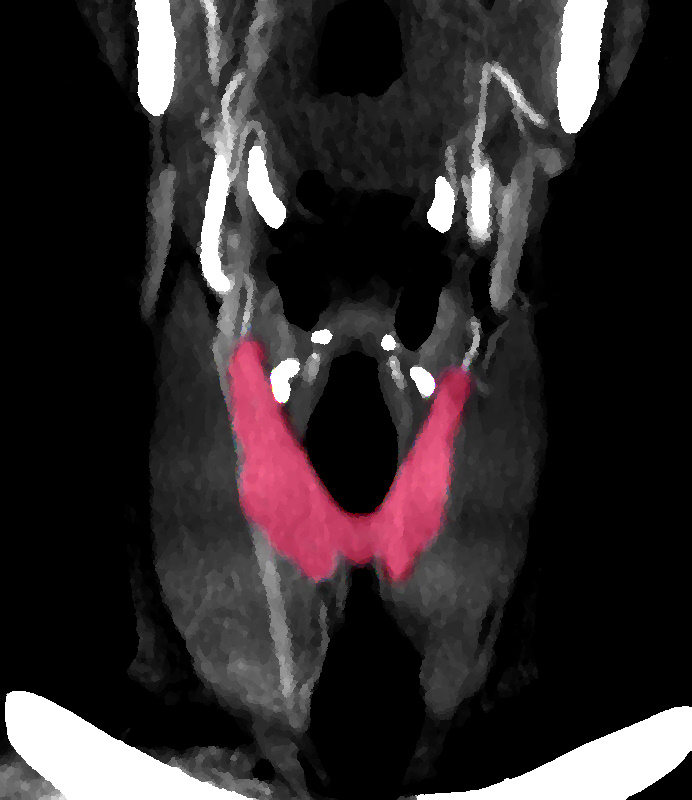Assistant
Introduction
An Overview
The anatomy of the thyroid may be assessed using five structural descriptors: size, shape, position, character, and connections.

The Thyroid in Context – An Overview |
|
The thyroid is front and center in the neck. This a coronal image of a normal thyroid in a 26 year old female reveals the size shape and position of the thyroid in the midst of some neighbouring structures. Copyright 2010 Courtesy Ashley Davidoff MD 93852..8kb05 |
Size
The thyroid is one of the largest endocrine organs in the body, weighing 15-35 grams and measuring 4-5cms in length by 2-2.5cms in width by 1-1.5cms thick in the average adult. The thyroid tends to be larger in women than in men.
The size of the thyroid changes with age, developing from 2-3 grams at birth to full size by age 25.
From a clinical standpoint, size is an especially important structural characteristic of the thyroid, as changes in thyroid size beyond those expected as a result of aging are often indicators of disease. Diagnoses of hyper- and hypothyroidism, two common thyroid disorders, are largely based on thyroid size, hyperthyroidism being associated with increased size and hypothyroidism being associated with atrophy. This is not always true since a single hyperfunctioning nodule will cause an overall decrease in size of the gland because the normal gland gets suppressed by excessive thyroxine.
Fortunately, thyroid size is easily measured using ultrasound which is a safe and universally available tool. Linear measurements are the standard for most evaluations.
Shape
The thyroid is a butterfly-shaped gland with two lobes each cone shaped, connected by a narrow band of tissue called the isthmus.
The shape of the thyroid cannot be evaluated by clinical examination; however, the “thyroid neck check,” which requires a patient to observe his/her neck for asymmetrical bulges while swallowing, may reveal irregularities in its shape.
Position
The thyroid lies on the anterior side of the neck, against and around the trachea, and reaches posteriorly to touch the esophagus. Its position here is not fixed, however, as swallowing causes it to move along the trachea.
Character
The thyroid gland is a brownish color in the fresh state.
The imaging characteristics of the thyroid are far more revealing. These characteristics are most easily observed using ultrasound.
Parts
The thyroid consists of a right and left lobe connected by the isthmus. Sometimes a pyramidal lobe projects from the isthmus or from one of the lobes. The thyroid tissue consists of lobules and each lobule is made of 20-30 follicles.
Blood Supply
The thyroid receives blood from two major sources; the superior thyroid artery, which is a branch of the external carotid artery, and the inferior thyroid artery, which is a branch of the thyrocervical trunk, which in turn arises from the subclavian artery. The thyroid ima artery, is an inconsistent third branch which arises from the brachiocephalic trunk.
Venous Drainage
There are 3 major draining veins; the superior middle and and inferior thyroid veins.
Lymphatic Drainage
The thyroid is surrounded by a rich network of lymphatics. There are approximately 300 lymph nodes in the neck, and flow crosses the midline and continues both superiorly and inferiorly.
There are about 13 named sets of lymph nodes that serve to drain the neck and the region of the thyroid gland.
Nerve Supply
The thyroid receives innervation from both the sympathetic and parasympathetic nervous systems, which are subsets of the autonomic nervous system. Sympathetic input is supplied by the superior cervical ganglion and the cervicothoracic ganglion while parasympathetic input is supplied by the superior laryngeal nerve and the recurrent laryngeal nerve.
Embryology –
The thyroid gland is the first endocrine gland to develop in the embryonal stage at approximately the 24th day of gestation as an outpouching at the base of the tongue in the foramen cecum on the median surface of the developing pharyngeal floor.
Growth and Aging –
The thyroid loses volume with aging and in fact metabolism gradually slows beginning around age 20. However functionally aging only affects the thyroid in minor ways with a slight decrease in T3 levels. Disease of the thyroid such as autoimmnune disorders become more prevalent with age.
Conclusion
The thyroid gland is a a large gland by endocrine standards, but is rather small compared to most other organs in the body. for such a small organ it has rather a important responsibility to controls the basic metabolic rate of the body. Structurally its shape is rather unique, and its superficial position make it easily examined both clinically and with imaging. Its close relationship ith the recurrent laryngel nerves, esophagus and parathyroids requires meticulous technique in surgery.
References
Lyoyd R.V Endocrine Pathology: Differential Diagnosis and Molecular Advances 3rd edition Thyroid Pathology Springer New York
Nguyen, Mai H.MD., Quinn, Francis B. MD Thyroid Cancer – A Review of the Thyroid -UTMB.edu History anatomy embryology and thyroid cancer information
Dorion D MD, MSc, FRCSC, FACS, David Lemaire, D MD Thyroid Anatomy eMedicine
